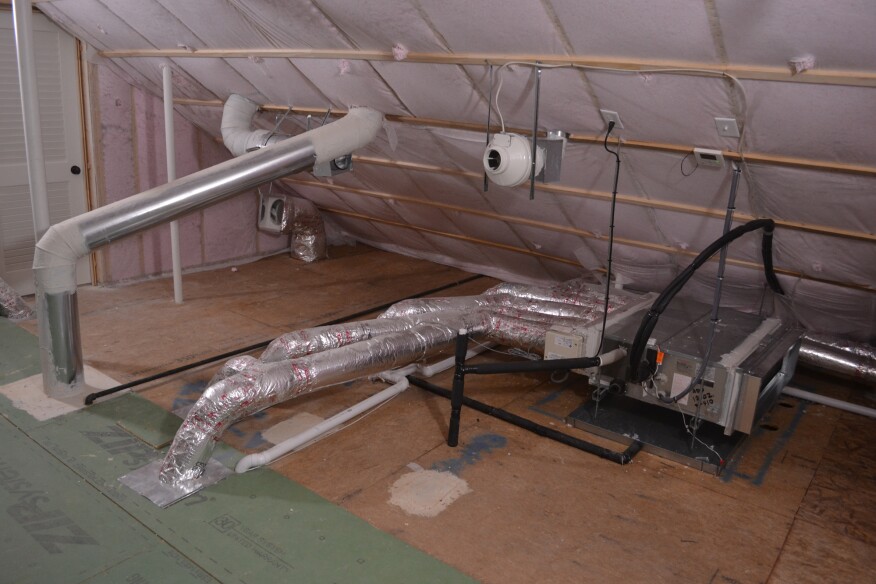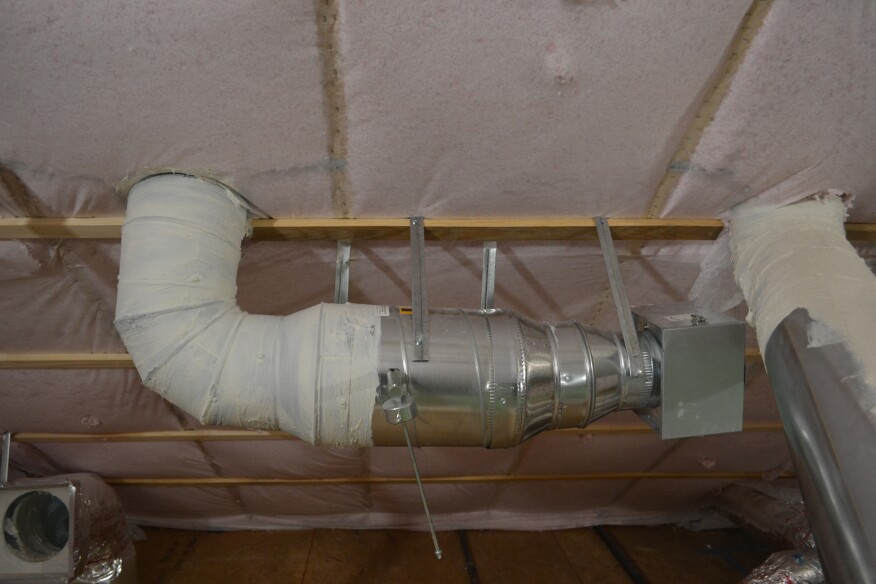Airtight superinsulated homes require a reliable supply of fresh air. These days, the usual solution for providing that air is to install a heat recovery ventilator (HRV) or an energy recovery ventilator (ERV). HRV systems, of course, transfer heat between the outgoing and incoming air streams, while ERVs have an “enthalpy core” that transfers water vapor as well as heat between the air streams. Both devices warm up the intake air during cold weather and cool it down during warm weather, to reduce the load on the HVAC system.

But a state-of-the-art HRV or ERV comes with a hefty price tag. And depending on the climate and the heating and cooling needs of the house, the savings on space conditioning energy may not justify the cost of installing an ERV—or perhaps even the cost of operating it.
My company has installed many ERV systems, and we’ve recommended an ERV for dozens of homes. But ERVs are not the only way to bring fresh air into a house, and recently we’ve had very good success with a simpler (and less expensive) strategy. We use a semi-conditioned space such as an encapsulated attic or a basement mechanical room to act as a large “buffer zone” for a small, controlled amount of continuously supplied incoming fresh air. Makeup air for kitchen and bath exhaust fans also is brought into this buffer space as needed. The fresh air mixes with the semi-conditioned air already in the space, then is drawn into the HVAC equipment for conditioning and distributed to the home’s living space through the HVAC system’s supply ducts. This solution has proven to work quite well, and its initial cost as well as its power requirements are lower than for an ERV.

Intake and Distribution
The photos in this article show the equipment we installed several years ago in our extremely tight (0.47 Ach50), PV-equipped, net-zero “High Performance Bungalow” near Atlanta, where the setup we devised has been performing beautifully for several years.
The home’s very low heating and cooling requirements are easily handled by a 2.5-ton ducted Daikin SkyAir minisplit heat pump with a heating capacity of 34,000 Btu per hour and a cooling capacity of 30,000 Btu per hour. We paired the heat pump with Daikin’s five-zone DZK zoning kit, which allows independent thermostatic control of five zones (Daikin also makes a four-zone and a six-zone version of this same device).

The minisplit’s air handler circulates air through the home 24 hours a day. The variable refrigerant flow (VRF) heat-pump system has an inverter compressor in the outdoor unit that varies the power consumption and output, and the indoor air handler has a linear expansion valve that also varies the amount of refrigerant entering the coil, to satisfy the instantaneous demand. The system efficiently supplies just a trickle of heating and cooling as needed by any of the five zones. The continuously operating, quiet, and efficient fan is well suited for the distribution of fresh air.

We bring that fresh air into the house with two independently operating intakes located in the buffer space. A Fantech FR-125 inline fan with a 4-inch duct serves one intake vent, controlled by a Fantech switch in the laundry room on the main level. The fan can move as much as 200 cubic feet per minute (cfm), but we initially set it to 20 or 30 cfm and advise the homeowner to keep it there.
The continuous stream of fresh air drawn in by this fan is dumped directly into the attic, where it is tempered and preconditioned by mixing with air in the space. Then the air is drawn into the open return side of the air handler (located just a few feet away from the inlet) and distributed via the air handler to the occupied rooms in the house below.
The other intake vent provides makeup air as needed for the 400-cfm kitchen range exhaust vent. This intake is connected to a 10-inch Broan barometric damper, which opens whenever there’s negative pressure in the house. A lever with a counterweight allows the damper to open only as far as needed to provide the volume of air that the range hood needs. Again, the outdoor air moves first into the semi-conditioned buffer space, where it mixes with return air that is coming from conditioned rooms in the house through a series of large jumper ducts in the ceiling of each bedroom and through louvered doors that separate the attic and the conditioned space. Should there happen to be another source of makeup air (such as an open window), the range hood might not depressurize the house; in that case, the damper stays closed.
When the kitchen exhaust is running for typical short durations, most of the air entering the kitchen will be tempered air that has already mixed with other attic air, rather than hot or cold air drawn directly from outside, so the kitchen doesn’t get a direct, harsh blast of outdoor air. Most of the air drawn into the attic through the dampered vent will end up being conditioned by the minisplit and distributed into the rooms of the house via the air handler and its five supply ducts.
Keeping Controls Simple
Our solution is mechanically simple. Another advantage to this approach is that it’s “dumb” for the user—homeowners have no difficulty understanding it or operating it. We don’t give the owners control over bath exhaust vents—the Panasonic bath fans are set to run continuously at a low level and to boost for a few minutes whenever the occupancy sensor indicates that the bathroom is in use. That way, they don’t have to think about it.
The owners are in charge of the kitchen range hood’s exhaust vent; we emphasize to all our clients the importance of using their range hood fan every time they cook, and they seem to do that religiously. But they don’t have to think about the makeup air when they’re cooking; the intake vent opens and closes on its own and has no power requirement.
The owners also can adjust the air volume supplied by the continuous intake vent fan to satisfy their own comfort needs. If a house is full of guests and their pets, for instance, it’s easy for the owners to boost that fresh air supply. We didn’t want to automate that; in our view, the owners best know how much fresh air they need and want from one day to the next.
At full power, the intake fan by itself would supply two or three times as much air as specified by ASHRAE 62.2, the industry standard for ventilation. But realistically, the building’s operable windows and doors let in a lot of fresh air during the occupants’ normal daily activities. So far, the homeowners have been happy to keep the intake fan at its initial 20-cfm setting.
For an off-the-grid project (currently under construction) that we designed in the North Carolina mountains, we needed to provide a greater degree of flexibility. The owners of that house expect to often have gatherings of 20 or more guests, and they want to be able to boost their fresh air supply fan accordingly. To simplify the controls for that house, we’re having a custom plate made for the twist dial that controls the intake air fan, indicating not the cfm of the fan, but the number of people in the house. That way, the owners can simply set the fan according to the number of guests: two people, five people, 10 people, and so on.
Monitoring Performance
When we first started to use this method for fresh air supply, we recognized that it was an original approach, and we wanted to be careful about measuring and documenting the results. So in our “High Performance Bungalow,” we installed sensors in the attic and throughout the house to record the levels of volatile organic compounds (VOCs), the concentrations of fine particulates (PM2.5), the relative and absolute humidity, the dew point, and the temperature. We monitor carbon monoxide levels with a device called the “Defender,” which would notify us if CO levels were to spike even a tiny amount, and we track the system’s energy consumption. After three years of occupancy, we’ve established that air quality in the home has been right on target, and that the system uses very little energy and adds very little to the home’s heating and cooling loads. We also keep an eye on the H2 (“Happy Homeowner”) sensor, and those readings have been maxed out at “Extremely.”
Photos by Chris Laumer-Giddens









